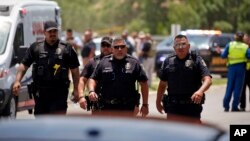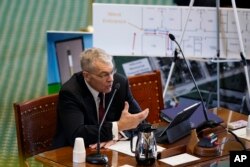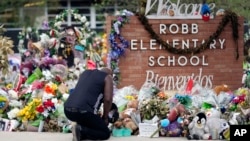In dramatic testimony before a special committee of the Texas Senate on Tuesday, the state's top law enforcement officer called the police response to last month's deadly school shooting in the town of Uvalde "an abject failure" that disregarded years of training and established law enforcement doctrine.
Testifying in Austin, Steven McCraw, the director of the Department of Public Safety, told lawmakers that three minutes after the gunman entered the school there were enough police officers and equipment on the scene to confront the gunman. However, police waited for more than an hour to enter the two connected classrooms where 19 students and two teachers were killed, in part because they believed the door to be locked.
McCraw, in his testimony, revealed that the classroom door was, in fact, unlocked.
"The officers had weapons; the children had none," McCraw said. "The officers had body armor; the children had none. The officers had training; the subject had none. One hour, 14 minutes and 8 seconds. That's how long children waited, and the teachers waited, in Room 111, to be rescued."
Still shooting after 40 minutes
The attack in Uvalde began on the morning of May 24, when an 18-year-old man carrying an AR-15-style semi-automatic rifle entered Robb Elementary School and began shooting. After entering the classrooms where the killings would occur, he fired through the door at three officers who followed him into the building, grazing two of them and forcing them back.
After that initial confrontation, responding police stayed away from the door until it was finally breached more than an hour later.
The killer continued firing inside the classroom in bursts, according to the video footage, which indicates that he was still shooting more than 40 minutes after he entered the school.
Police chief blamed
In his testimony, McCraw laid the blame for the slow police response on Uvalde School District Police Chief Pete Arredondo who, he said, "decided to put the lives of officers before the lives of children." Arredondo's police department has six officers and is independent of Uvalde's municipal police department.
McCraw walked lawmakers through a detailed timeline of the incident. He told them that within three minutes of the killer entering the building there was "a sufficient number of armed officers wearing body armor to isolate, distract and neutralize the subject." Five minutes later, he said, an officer reported that they had access to a Halligan bar — a device that firefighters use to breach locked doors.
He confirmed the accuracy of video footage obtained by news organizations on Monday which showed that 19 minutes after the killer entered the building, officers on the scene had a ballistic shield available to protect them from incoming fire if they entered the classroom. As many as 19 officers from various agencies could be seen on the video milling around in the school hallway .
Nevertheless, he said, it would be another 58 minutes before a team of officers from the U.S. Border Patrol, not the Uvalde School District Police, entered the classroom and killed the gunman.
Arredondo has said publicly that he did not consider himself to be the person in charge of the police response to the shooting, an assertion that McCraw rejected during his testimony.
"If you're going to issue commands, if you're going to direct action," McCraw said, "you're the on-scene commander."
'Antithetical' to training
McCraw told lawmakers that the response to the shooting was "antithetical to everything we've learned over the past two decades."
McCraw was referring to the 1999 massacre at Columbine High School in Columbine, Colorado. In that incident, two teenage gunmen killed a dozen students and one teacher and wounded more than 20 others. A police Special Weapons and Tactics (SWAT) team waited nearly two hours to enter the school building, leading to an angry public outcry after the fact.
In the months and years after the Columbine attack, police training and doctrine shifted decisively in the direction of initiating immediate confrontation with active shooters, even if that confrontation puts responding police officers in danger.
In video from inside Robb Elementary School in Uvalde, it appears that several of the responding officers recognized that they were being ordered to disregard their training.
"If there's kids in there, we need to go in there," one officer can be heard saying, some 20 minutes after the gunman entered the classroom.
'Gruesome' stories
During the hearing on Tuesday, state senators on the committee were highly critical of the police response and called on Arredondo to answer questions in public. So far, the police chief has testified only in closed hearings.
The committee invited Senator Roland Gutierrez, a Democrat who represents Uvalde in the state senate, to address its members, and he delivered a highly emotional message describing his interactions with his constituents in the wake of the shooting.
He described being present when parents learned that their children were among the dead, and recounted attending multiple viewings and funerals.
"I went to as many viewings as I could," Gutierrez said. "I saw seven baby girls and their coffins. And I did this because I wanted to come back and talk to you all and tell you what I saw and tell you the things that you don't ever want to see in your communities.
"I have heard the most gruesome stories, from little kids, fourth graders — stories that I dare not say at this time," he said. "I'd be glad to talk to you all privately (about) what little kids heard and saw that day."
Changing story
In the weeks following the shooting in Uvalde, the story of how the police response unfolded changed significantly. In the immediate aftermath of the attack, Texas Governor Greg Abbott praised the police response, saying that their actions put an end to a situation that "could have been worse" if they had not shown "amazing courage by running toward gunfire."
Arrendondo himself told reporters that he and one of his officers had tried the classroom doors and found them to be locked, a claim that McCraw challenged in Tuesday's hearing.
Abbott would later describe himself as "livid" after the real nature of the police response was revealed to him after the fact.








